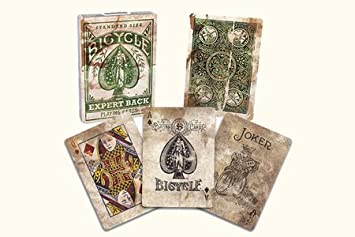Distressing is a technique that gets employed to make objects look more aged, worn, or used than they are.
It’s a method that I was first introduced to as a guitarist.
A lot of people enjoy the look and feel of a well-played guitar. But unless you buy vintage from the beginning, it can take decades of knocking a guitar around to achieve the desired level of “worn”.
It takes a lot of effort to create wear where there isn’t.
Surprisingly, it can be worth it. (For the feel, the sound, or the effect of it.)

What about distressing and cards?
Many magicians don’t like the shuffle of their brand new decks as much as their older ones. I’d imagine that, occasionally, the same might be true for card players. You might even need a card deck for a themed party, or photoshoot. Who knows?
Always remember to avoid any markings that can individually identify any cards when they’re face-down. That isn’t distressing the deck, that’s accidentally marking it for a would-be cheater.
If you’d like to age a deck for playing-purposes, be more careful with your approach.
Here are a handful of basic techniques for distressing decks.
Around The Bend
New card decks can feel “tight” to the touch for their first couple of shuffle sessions. Remember that new card decks haven’t experienced any shuffling, moving or bending before.
How do you simulate the movement of a hundred shuffles?
A deck has to be slowly curved until losing the initial tightness of the cardboard. One way, then the other way. Be careful of bending either too much or too far. Moderate wear is best.
Wearing The Sides
Decks can develop a considerable amount of wear on the sides over time. Just take a look at any older deck to see it.
If you don’t have the time and want simulated wear, extra fine sandpaper tracked around the sides can create the necessary look.
Don’t overdo it.
Did You Finish?
New card decks have a glossy finish.
It’s a laminated coating that keeps oils and dust from sticking to the cards. As a deck gets shuffled and worked, this coating will naturally be worked off with time.
When you’re distressing cards, you can speed up the process.
Extra-fine sandpaper lightly brushed across the card-faces should do the trick. (Yes, you’ll have to repeat this step 54 times if you’d like to do the Jokers, too.)
If you skip this step, any further distressing (like coffee or tea) has nothing to adhere to.
The Deck Itself
Older decks are exposed to a lot of stress over the years.
Examples include sunlight, smoke, dust, and oils that can eventually affect the finish.
Simulating these types of wear can be easier than you think.
Cards can be rubbed with coffee or tea (after they have been lightly sanded). They can also be buried in soil for a few days (or weeks) until the distressed look or feel has been achieved.
What Else?
Most decks are sold with packaging.
For any attempts to distress the deck, don’t forget to do the same to the box. It’s not absolutely required, but it just completes the picture of a vintage-looking deck.
If you’d like to skip the distressing altogether and buy a completed deck, Bicycle has many appropriate decks part of their vintage reproduction series.
